
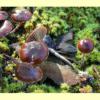
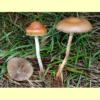
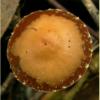
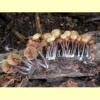
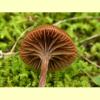
_AK_18_sml.jpg)
Psilocybe has recently been split into two genera: Deconica (Strophariaceae) and Psilocybe in the strict sense (Hymenogastraceae), the latter contains blue-staining species formerly placed in section Caerulescentes (such as P. cubensis, P. semilanceata, P. subaeruginosa and P. subcubensis), while species such as P. coprophila, P. inquilina and P. merdaria belong in Deconica. Placement of other Australian species has not yet been established.
Bougher, N.L. & Syme, K. (1998), Fungi of Southern Australia. University of Western Australia Press, Nedlands. [Description, Illustration and Microcharacters of P. coprophila]
Breitenbach, J. & Kränzlin, F. (eds) (1995), Fungi of Switzerland. Volume 4. Agarics 2nd part. Edition Mykologia, Lucerne. [Description, Microcharacters and Illustration of P. coprophila, P. inquilina, P. merdaria and P. semilanceata and six other species from Europe]
Chang, Y.S. & Mills, A.K. (1992), Re-examination of Psilocybe subaeruginosa and related species with comparative morphology, isozymes and mating compatibility studies, Mycol. Res. 96: 429–441. [discussion of circumscription of P. subaeruginosa (including P. tasmaniana) along with illustration of Microcharacters]
Chang, Y.S., Gates, G.M. & Ratkowsky, D.A. (2006), Some new species of the Strophariaceae (Agaricales) in Tasmania, Australas. Mycol. 24: 53–68. [B&W Illustration, Description and Microcharacters of P. alutacea and P. brunneoalbescens]
Fuhrer, B. (2005), A Field Guide to Australian Fungi. Bloomings Books, Hawthorn. [Description and Illustration of P. subaeruginosa]
Grgurinovic, C.A. (1997a), Larger Fungi of South Australia. The Botanic Gardens of Adelaide and State Herbarium and The Flora and Fauna of South Australia Handbooks Committee, Adelaide. [Description and Microcharacters of P. argentina, P. kolya, P. korra, P. kramburkicola, P. musci, P. stercicola, P. subaeruginosa and P. toogaadyalis, along with Illustration of P. argentina and Key to South Australian species]
Guzmán, G. (1983), The genus Psilocybe, Beih. Nova Hedwigia 74: 1–439. [Description and Microcharacters of P. argentina, P. coprophila, P. cubensis, P. inquilina, P. merdaria, P. semilanceata, P. subaeruginosa (also as P. australiana and P. eucalypta), P. subcubensis and P. tasmaniana, along with B&W Illustration of P. argentina, P. merdaria, P. subaeruginosa (and as P. australiana) and P. tasmaniana, and Illustration of P. coprophila, P. cubensis, P. semilanceata and P. subcubensis, and also including worldwide Key to species of Psilocybe]
Guzmán, G. & Watling, R. (1978), Studies in Australian agarics and boletes. I: some species of Psilocybe, Notes Roy. Bot. Gard. Edinburgh 36: 199–210. [Description and Microcharacters of P. subaeruginosa (as P. australiana and P. eucalypta) and P. tasmaniana]
Johnston, P.R. & Buchanan, P.K. (1995), The genus Psilocybe (Agaricales) in New Zealand, New Zealand J. Bot. 33: 379–388. [Description and Microcharacters of P. argentina, P. coprophila, P. semilanceata and P. subaeruginosa from New Zealand]
Margot, P. & Watling, R. (1981), Studies in Australian agarics and boletes. II. Further studies in Psilocybe, Trans. Brit. Mycol. Soc. 76: 485–489. [Description and Microcharacters of P. cubensis]
McCann, I.R. (2003), Australian Fungi Illustrated. Macdown Productions, Vermont. [Illustration of P. coprophila and P. subaeruginosa]
Miller, O.K., Jr & Hilton, R.N. (1987), New and interesting agarics from Western Australia, Sydowia 39: 126–137. [Description, B&W Illustration and Microcharacters of P. merdaria]
Young, A.M. (2005b), A Field Guide to the Fungi of Australia. University of New South Wales Press, Sydney. [Description and B&W Illustration of P. subaeruginosa]
